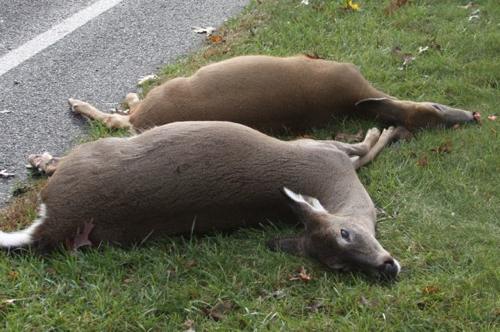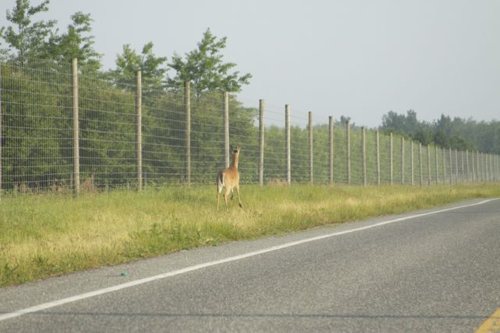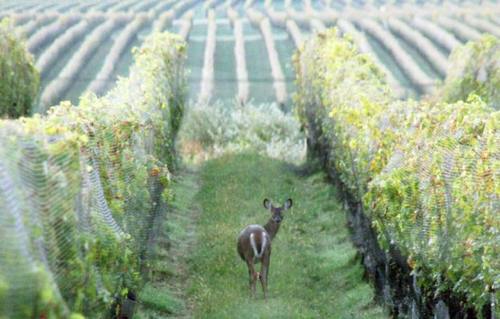It’s mating season for white tailed deer, and that means you’d better watch out for bucks with one thing on their minds — and the does running away from them.
About two-thirds of the estimated 70,000 deer-vehicle accidents annually in New York state occur during October, November and December — white tailed deer mating season — according to the state.
Since the beginning of the month, Riverhead Town highway crews have been picking up three to five dead deer every day, Highway Superintendent Gio Woodson said.
Riverhead Town police don’t keep separate statistics on motor vehicle accidents involving deer, according to Chief David Hegermiller, but the numbers are higher this time of year.
Nationwide, an estimated 29,000 people are injured and more than 200 people die in motor vehicle accidents involving deer — often as a result of drivers swerving to avoid a deer and running off the road or into oncoming traffic, according to Cornell Cooperative Extension. Auto accidents involving deer account for more than $1 billion in vehicle damage, as well.
 The problem is actually much bigger that this, because only about half of all deer-vehicle collisions are reported to police, and less than half are reported to insurance companies, according to CCE. Even so, the reported numbers have increased more than 24 percent over the past decade — something wildlife experts say is tied directly to the increase in the white-tailed deer population.
The problem is actually much bigger that this, because only about half of all deer-vehicle collisions are reported to police, and less than half are reported to insurance companies, according to CCE. Even so, the reported numbers have increased more than 24 percent over the past decade — something wildlife experts say is tied directly to the increase in the white-tailed deer population.
Local auto body shops report see uptick in business related to deer collisions every fall, but in recent years, they say, deer collisions have become common throughout the year.
“It’s not just November any more, by any stretch of the imagination. You’ve got people in the summer hitting deer,” said Richard Russo of Elrich Auto Body in Aquebogue. Russo said his shop averages a couple of deer collisions every week throughout the year, with more in the fall. They repair about 150 vehicles damaged in deer collisions a year, Russo said. The price-tag can run between $3,000 and $15,000, depending on the make and model of the vehicle, he said.
 Auto parts stores sell “deer whistles” that attach to the bumper and produce a high-pitched noise that’s supposed to stop deer in their tracks. They cost about $6 each. Opinion about their effectiveness is mixed.
Auto parts stores sell “deer whistles” that attach to the bumper and produce a high-pitched noise that’s supposed to stop deer in their tracks. They cost about $6 each. Opinion about their effectiveness is mixed.
Doug Turbush at BJ Auto Parts in Riverhead said the low-priced whistles are popular items.
“For the cost, people figure it can’t hurt,” he said.
The best defense against hitting a deer is defensive driving, according to CCE. Be especially cautious during the hours of dawn and dusk, when deer are most active. Remember, deer travel in groups, so if you see one, there are more in the area. Slow down and be prepared to stop. If a deer enters your path and you can’t stop, don’t swerve to avoid hitting the animal. That could take you off the road or into oncoming traffic, increasing your risk of vehicle damage and personal injury.
How many deer are there in Suffolk County?
Ironically, perhaps, the rebound of white-tailed deer populations in the U.S. is considered a wildlife management success story. At the turn of the last century, there were only about half a million deer in the entire country. Today, the U.S. deer population is estimated at more than 20 million, according to CCE.
At the same time, land available for hunting has declined, as has an interest in hunting, according to the state Department of Environmental Conservation, which this month issued a five-year deer management plan that includes measures to reduce constraints on deer-hunting on Long Island and expand the hunting season.
Last year, nearly 3,000 deer were harvested in Suffolk County during hunting season — the regular season, for bowhunting only, runs from Oct. 1 through Dec. 31, and there’s a special firearms season in January. But the annual hunting harvest doesn’t even put a dent in the problem — and the problem goes beyond car crashes.
There are no official estimates of the deer population on Long Island. The state DEC says it’s difficult to arrive at good numbers, but the agency compiles harvest numbers as well as sightings by bowhunters.
“The deer population is out of control,” said Long Island Farm Bureau executive director Joe Gergela last week at a N.Y. State Senate regional forum convened in Riverhead. “A comprehensive regional management plan is needed.”
Deer-related crop damage is valued at more than $59 million a year in New York, according to CCE. About one-quarter of the state’s farmers say deer damage is a significant contributing factor affecting the profits of their farm.
 It’s particularly acute on Long Island, where the deer population is at a record high and where crops grown are especially vulnerable to deer damage. In an effort to stem their losses, 85 local farmers have erected deer fencing, according to Gergela. The 10- or 12-foot-high woven wire fencing can cost anywhere from $150 to $600 an acre to install.
It’s particularly acute on Long Island, where the deer population is at a record high and where crops grown are especially vulnerable to deer damage. In an effort to stem their losses, 85 local farmers have erected deer fencing, according to Gergela. The 10- or 12-foot-high woven wire fencing can cost anywhere from $150 to $600 an acre to install.
Grant money helped pay for the fencing, but, Gergela says, “at this point we have more requests than we have funds.”
“It’s an inadequate solution,” Gergela said.
Then there are the health issues related to the burgeoning deer population. New cases of Lyme disease in New York exceed 4,000 to 5,000 every year, according to the Centers for Disease Control and Prevention. Most of those occur on Long Island, where Lyme disease is considered by health officials to be occurring in epidemic proportions.
Humans contract Lyme disease, a bacterial infection, when they are bitten by an infected tick. Ixodes dammini — commonly known as the deer tick because in its adult stage in prefers to feed on white-tailed deer — is the most common source of the disease. Because the bite is painless and in its early stages it is often without symptoms, Lyme disease is difficult to diagnose. It can cause many serious health problems if undiagnosed, including neurological, cardiac, eye, respiratory and gastrointestinal problems, according to the CDC.
State DEC releases 2012-2016 deer management plan
 The economic and health impacts of the deer population explosion were factors considered by state regulators when in 2009 they set about to develop the multi-year deer management plan released earlier this month.
The economic and health impacts of the deer population explosion were factors considered by state regulators when in 2009 they set about to develop the multi-year deer management plan released earlier this month.
The plan calls for expanding the bag limits for anterless deer, expanding the bow-hunting season by 15 days and establishing a special youth deer-hunting season to encourage hunting among young people. It also proposes lowering New York’s minimum age for big-game hunting with a firearm to age 12.
The DEC plan says cross-bow hunting for deer should be legalized in all seasons, not just during the regular firearms season, as current law allows.
It also calls for reducing the setback for discharge of a cross-bow or long bow from 500 feet to 150 feet from a structure.
The DEC plan also would remove some constraints currently placed on hunters on Long Island. It suggests eliminating the need for town permits for the special January firearms season in Suffolk, and also allowing bowhunting for deer in Suffolk during the special January firearms season.
The January season should be modified to include weekends, according to the plan; current law limits hunting in January to weekdays.
The state environmental conservation agency does not endorse the use of fertility control measures, which it says are inefficient and less cost-effective than direct removal of deer through hunting or culling.
RiverheadLOCAL photos by Peter Blasl.
The survival of local journalism depends on your support.
We are a small family-owned operation. You rely on us to stay informed, and we depend on you to make our work possible. Just a few dollars can help us continue to bring this important service to our community.
Support RiverheadLOCAL today.
































